RTO Vehicle Information: Access Vehicle Owner Details at Parivahan.gov.in
The Regional Transport Office RTO Vehicle Information plays a crucial role in managing vehicle registrations, issuing driving licenses, and ensuring that road safety laws are followed across India. As a vehicle owner, it’s essential to know how to access key vehicle information, including ownership details, fitness certificates, insurance status, and more.
With the digital revolution, checking RTO vehicle information has become easier than ever. You can now access all your vehicle details online through government platforms like Parivahan.gov.in and the VAHAN website. Here’s everything you need to know about RTO vehicle details and how to check them quickly online.
What is RTO Vehicle Information?
RTO vehicle information refers to the official data stored in the Regional Transport Office’s database, which includes essential details about your vehicle’s registration. This information is vital for verifying ownership, checking the status of the vehicle, and ensuring legal compliance. The Parivahan and VAHAN platforms provide an easy way for individuals to access this data online.
Key Details in RTO Vehicle Information:
- Vehicle Registration Number: A unique identifier for your vehicle.
- Owner’s Name: Name of the person or entity that owns the vehicle.
- Registration Date: The date when the vehicle was officially registered.
- Chassis and Engine Number: Unique numbers used to identify the vehicle (partially visible for privacy).
- Fuel Type: Whether the vehicle runs on petrol, diesel, CNG, or electricity.
- Vehicle Class: Indicates whether the vehicle is a private or commercial vehicle, or a two-wheeler or four-wheeler.
- Fitness Certificate Status: Whether the vehicle is roadworthy.
- Pollution Under Control (PUC) Status: Indicates if the vehicle meets pollution norms.
- Insurance Validity: The status and validity of the vehicle’s insurance.
- Road Tax Details: Information regarding any applicable road tax payments.
You can also read: Driving Licence Online
How to Check RTO Vehicle Information Online?
Thanks to advancements in digital platforms, you no longer have to visit an RTO office physically. You can easily check your vehicle details through the Parivahan or VAHAN portals. Here’s a step-by-step guide on how to access your vehicle’s registration details online.
Via the VAHAN Portal:

- Visit the official VAHAN website: https://vahan.parivahan.gov.in or https://parivahan.gov.in.
- Navigate to the Know Your Vehicle Details section.
- Enter your vehicle registration number (e.g., MH15AB1234) and the captcha code.
- Click on Search Vehicle to view the details.

Via the mParivahan Mobile App:
- Download the mParivahan app from the Google Play Store or Apple App Store.
- Log in using your registered mobile number.
- Enter your vehicle registration number to access detailed information about your vehicle, including the owner’s name, fitness validity, and insurance status.

Pro Tip: On the mParivahan app, you can also create a virtual RC and check your vehicle’s challan status.
Importance of RTO Vehicle Information
Legal Compliance
Vehicle registration is mandatory under the Motor Vehicles Act, 1988, and is required for legal road use. The RTO vehicle details confirm that your vehicle complies with all relevant laws, making it a legal entity on the road.
Ownership Proof
The RTO vehicle record serves as the official proof of ownership, which is important for transferring ownership or selling the vehicle. It helps prevent fraud and ensures that the rightful owner is acknowledged in legal matters.
3. Insurance and Claims
A valid RTO vehicle registration is required for insurance purposes. Claims for accidents or damage can only be processed if the vehicle is registered with the RTO. It’s also necessary to ensure that your vehicle’s insurance policy is active and valid.
4. Fitness and Pollution Checks
The RTO provides certification that your vehicle meets roadworthiness and pollution control standards. These checks ensure that vehicles on the road are safe and do not contribute excessively to pollution.
Vehicle Registration Process: Step by Step
To ensure your vehicle is legally registered, follow these simple steps:
Temporary Registration
When purchasing a new vehicle, you receive a temporary registration valid for up to 30 days. This allows you to drive the vehicle while waiting for the permanent registration.
Permanent Registration
To obtain permanent registration:
- Visit the RTO with your documents, including the sales invoice, manufacturer’s certificate, insurance certificate, and Pollution Under Control (PUC) certificate.
- Pay the necessary road tax and submit all documents.
- The RTO will inspect your vehicle before issuing a permanent registration certificate (RC).
Fancy Number Registration
For those who wish to have a unique registration number, you can request a fancy number through the RTO. This number is assigned based on availability and can be obtained via an auction.
What to Do if Your RC is Lost?
If you lose your Registration Certificate (RC) or it gets damaged, you can apply for a duplicate RC through the following process:
- File an FIR at the local police station.
- Visit the RTO with the Form 26 and necessary documents.
- Pay the applicable fee for the duplicate RC.
Once verified, you’ll receive a new RC.
RTO’s Role in Vehicle Fraud Prevention
RTOs maintain a robust database of vehicle information that helps prevent fraud. By ensuring all vehicle details are recorded and accessible, the RTO makes it difficult for stolen or unregistered vehicles to be sold.
This transparency also protects buyers, as they can verify the vehicle’s details before making a purchase. This helps avoid fraudulent sales and ensures the legitimacy of vehicle ownership.
FAQs
Final Words
Accessing RTO vehicle information has never been easier. Thanks to platforms like Parivahan and VAHAN, you can quickly verify important details about your vehicle, including ownership, insurance, fitness status, and more. By ensuring your vehicle registration is up-to-date and your documents are in order, you can drive with confidence, knowing that your vehicle is compliant with Indian road laws.
Make sure to use the official channels to check your vehicle’s details and stay informed about the legal requirements for vehicle ownership and registration.
